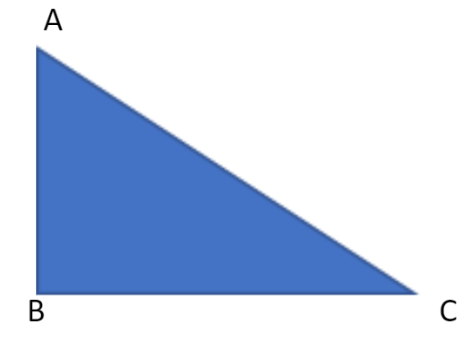
How do you find the value of ${\cos ^{ - 1}}( - 1)$?
Answer
480.6k+ views
Hint: In trigonometry, cosine or simply cos is defined by the ratio of length of the adjacent and the length of the hypotenuse.

If $\angle ACB = \theta $ , then $\cos \theta = \dfrac{{BC}}{{CA}}$ .
And ${\cos ^{ - 1}}$ or cosine inverse is the inverse function of cosine. In trigonometry, generally ${\cos ^{ - 1}}\theta $ i.e. The cosine inverse assigns a definite angle that has the same value of cosine to a given number. In other words, the cosine inverse function defines an angle, not a normal value.
Complete step-by-step solution:
In this question, we need to find the principal value of ${\cos ^{ - 1}}\left( { - 1} \right)$.
First, let us assign $y = {\cos ^{ - 1}}\left( { - 1} \right)$.
Taking $\cos $ both sides of the above equation, we have $\cos y = \cos \left\{ {{{\cos }^{ - 1}}\left( { - 1} \right)} \right\}$
i.e., $\cos y = ( - 1)$ … … …(i)
But we know, $\cos \pi = ( - 1)$ … … …(ii)
Then, comparing (i) and (ii), we obtain, $\cos y = \cos \pi $.
Now taking the function ${\cos ^{ - 1}}$ both sides of the above equation, we get
${\cos ^{ - 1}}\left\{ {\cos y} \right\} = {\cos ^{ - 1}}\left\{ {\cos \pi } \right\}$
i.e., $y = \pi $ .
Hence the principal value of $y = {\cos ^{ - 1}}\left( { - 1} \right)$ is given by $\pi $.
Note: For trigonometry, the principal value of ${\cos ^{ - 1}}\theta $ for $\theta > 0$ , is the length of the arc of a unit circle centred at the origin which subtends an angle at the centre whose cosine is $\theta $. Also, ${\cos ^{ - 1}}\theta $ can also be denoted by $\operatorname{arc} $ $\cos \theta $. Again, the solution by which the least value of the absolute angle is obtained, is named as the Principal Solution. Students should note that, if $\varphi $ be the Principal Value of $\cos $, then must be $0 \leqslant \varphi \leqslant \pi $. For example, the principal value of ${\cos ^{ - 1}}\left( {\dfrac{{\sqrt 3 }}{2}} \right)$ is $\dfrac{\pi }{6}$ and obviously, $\dfrac{\pi }{6} \in \left[ {0,\pi } \right]$.

If $\angle ACB = \theta $ , then $\cos \theta = \dfrac{{BC}}{{CA}}$ .
And ${\cos ^{ - 1}}$ or cosine inverse is the inverse function of cosine. In trigonometry, generally ${\cos ^{ - 1}}\theta $ i.e. The cosine inverse assigns a definite angle that has the same value of cosine to a given number. In other words, the cosine inverse function defines an angle, not a normal value.
Complete step-by-step solution:
In this question, we need to find the principal value of ${\cos ^{ - 1}}\left( { - 1} \right)$.
First, let us assign $y = {\cos ^{ - 1}}\left( { - 1} \right)$.
Taking $\cos $ both sides of the above equation, we have $\cos y = \cos \left\{ {{{\cos }^{ - 1}}\left( { - 1} \right)} \right\}$
i.e., $\cos y = ( - 1)$ … … …(i)
But we know, $\cos \pi = ( - 1)$ … … …(ii)
Then, comparing (i) and (ii), we obtain, $\cos y = \cos \pi $.
Now taking the function ${\cos ^{ - 1}}$ both sides of the above equation, we get
${\cos ^{ - 1}}\left\{ {\cos y} \right\} = {\cos ^{ - 1}}\left\{ {\cos \pi } \right\}$
i.e., $y = \pi $ .
Hence the principal value of $y = {\cos ^{ - 1}}\left( { - 1} \right)$ is given by $\pi $.
Note: For trigonometry, the principal value of ${\cos ^{ - 1}}\theta $ for $\theta > 0$ , is the length of the arc of a unit circle centred at the origin which subtends an angle at the centre whose cosine is $\theta $. Also, ${\cos ^{ - 1}}\theta $ can also be denoted by $\operatorname{arc} $ $\cos \theta $. Again, the solution by which the least value of the absolute angle is obtained, is named as the Principal Solution. Students should note that, if $\varphi $ be the Principal Value of $\cos $, then must be $0 \leqslant \varphi \leqslant \pi $. For example, the principal value of ${\cos ^{ - 1}}\left( {\dfrac{{\sqrt 3 }}{2}} \right)$ is $\dfrac{\pi }{6}$ and obviously, $\dfrac{\pi }{6} \in \left[ {0,\pi } \right]$.
Recently Updated Pages
Master Class 11 Economics: Engaging Questions & Answers for Success

Master Class 11 English: Engaging Questions & Answers for Success

Master Class 11 Social Science: Engaging Questions & Answers for Success

Master Class 11 Biology: Engaging Questions & Answers for Success

Class 11 Question and Answer - Your Ultimate Solutions Guide

Master Class 11 Business Studies: Engaging Questions & Answers for Success

Trending doubts
What is meant by exothermic and endothermic reactions class 11 chemistry CBSE

10 examples of friction in our daily life

One Metric ton is equal to kg A 10000 B 1000 C 100 class 11 physics CBSE

Difference Between Prokaryotic Cells and Eukaryotic Cells

What are Quantum numbers Explain the quantum number class 11 chemistry CBSE

1 Quintal is equal to a 110 kg b 10 kg c 100kg d 1000 class 11 physics CBSE




